Evaluation of Scottish transitional employment services: interim report August 2018
How programme design impacted the quality of delivery and customers’ experience of Work First and Work Able Scotland services in the first 6 months after launch.
Customer demographics and views on WFS and WAS
Key findings
Both programmes have engaged with a customer group that is broadly representative of their respective target client groups with the exception that:
- When considering the gender split in self-reported disabilities and health conditions, female customers are slightly underrepresented across both services.
- The customer groups are on average drawn from younger age groups, when the incidence of disability and health conditions rise steeply with age. That said, WAS participation up to the age of 55 is close to the profile of older people.
- Two-thirds of WAS customers have mental health conditions, well above benchmark levels and 86% reported that their condition had an impact on their ability to carry out day-to-day activities.
The characteristics of the customers responding to the telephone survey sample is very similar to that of all customers for both programmes:
- The main reasons that customers gave for engaging with WFS/ WAS are related to their strong desire to secure work and the offer of specialist help for people with disabilities or health conditions. Building confidence was reported as particularly important for WAS customers.
- Some 39% of WAS and 21% of WFS customers feel their disability or health condition prevents them from working, while 39% of WAS and 13% of WFS customers feel their mental health conditions prevent them from working. These mirror the proportion of both customer groups, who report that their health condition reduces their ability to carry out day-to-day activities 'a lot'.
- Similar proportions of both WFS and WAS customers (32% and 29%) are concerned about the impact work will have on their health and feel they need more social support in order to help them work.
- Almost seven in ten WFS and over eight in ten WAS customers found the regular one-to-one adviser appointments useful. The vast majority of customers on both programmes report that their frequency was about right (84% WFS and 85% WAS) with only a small minority saying that they were too frequent (6% WFS and 5% WAS).
- Occupational therapy and other health and wellbeing support was offered to proportionately more WAS customers (61%) than WFS (54%) reflecting their relative needs. A significant proportion of both groups (24% of WFS and 22% of WAS customers) offered such support did not take it up, but the vast majority that did use the support found it useful.
Customer characteristics
Introduction
This chapter presents a detailed summary of the characteristics of WFS and WAS customers in terms of basic demographics, employment status and history, conditions and benefits, and their programme participation. It draws on providers' MIS data for both services for the period 1 April to 31 October 2017 [6] and the telephone survey of 700 clients undertaken for this evaluation who started these services over the same period.
Current and former customers of the WFS and WAS services completed a telephone interview between 18 January and 5 February 2018, about their experience of the programme, its outcomes and their current situation.
A sample of 2,000 customers (n=1,458 WFS, n=452 WAS) was provided directly to IFF Research, with letters sent to all target customers in advance letting them know about the research and providing the opportunity to opt-out if desired. A target of 700 surveys was set, split proportionally by programme based on programme size and sample availability.
As expected, 700 surveys were completed, split as: n=499 for WFS and n=201 for WAS. The survey lasted an average of 20 minutes and 30 seconds.This section considers the extent to which customers of both services reflect what we know about the population of people with disabilities and long-term health conditions.
WFS customers
In total, there were 3,208 'starts' on WFS in the combined provider MIS data for the period 1 April to 31 October 2017 in the datasets provided in December 2017. However, not all of these have data for all the variables in each provider dataset, for example some 3,148 have actual start dates recorded and not all have a gender recorded. As a result, it should be noted that this combined provider data for WFS may not match statistics published by Scottish Government due to subsequent data revisions.
WFS customers have the following characteristics when compared to the available benchmarks for the Equality Act Disabled or with long-term health conditions [7] :
- Compared to Equality Act 2010 core disabled unemployed and inactive there are considerably more males starting WFS than females (Table 2.1).
- Under 50s disabled (25-34) are over-represented among participants with proportionately fewer over 50s compared to EA disabled unemployed and inactive. Participation of those over 55 is considerably below their prevalence among Equality Act disabled who are not working (Table 2.1).
Table 2.1 WFS customer starts by Gender and Age April-October 2017
| Male | % | Female | % | Total | EA not working | ||
|---|---|---|---|---|---|---|---|
| 16-24 | 333 | 64% | 187 | 36% | 523 | 17% | 13% |
| 25-34 | 449 | 68% | 214 | 32% | 666 | 21% | 12% |
| 35-49 | 627 | 64% | 359 | 36% | 996 | 32% | 26% |
| 50-64 | 593 | 64% | 327 | 36% | 928 | 30% | 48% |
| Total | 2002 | 65% | 1087 | 35% | 3,113 | 371,000 | |
| EA Core disabled not working | 43% | 57% | |||||
Source: WFS Combined Provider MIS data April-October 2017 and APS Jan-Dec 2016.
A small number of clients declined to provide information on gender and not all clients have ages or start dates recorded and so the total recorded does not match the 3,208 clients who started WFS.
- Long-term health conditions are recorded slightly differently across the three providers and do not map directly onto categories used in Annual Population Survey ( APS) data for disabled people in Scotland (Table 2.2).
- Mental health is the most significant category with all providers reporting a high proportion of clients with depression and anxiety disorders, at a similar level to that identified in the wider population.
- Those with physical disabilities appear under-represented among participants. However, differences between the WFS provider classifications and APS make direct comparisons difficult.
- Long-term health conditions are not recorded in APS nor are development disorders and neurological conditions. The Family Resources Survey suggest that WFS engaged with a similar proportion of people with learning disabilities or difficulties.
- Although a much smaller proportion, people with hearing or sight loss make up almost 7% of WFS clients compared to a combined 2% of the out of work disabled group. FRS, on the other hand, suggests that WFS has not engaged fewer people with hearing or vision impairments that make up the working age population.
- Data on prior spells of unemployment were available for just one WFS provider. Just over two-thirds of customers (68%) had been previously unemployed for more than 12 months.
- WFS Retention customers – people who were at risk of losing their existing employment due to their health condition represent fewer than 2% of starts.
Table 2.2 Primary health condition of WFS starts April-October 2017
| Main health condition | WFS customers | % | EA out of work | FRS Working Age |
|---|---|---|---|---|
| Mental Health Condition | 1,003 | 34.2% | 32% | 36% |
| Long-Term Illness, Disease or Condition | 497 | 17.0% | ||
| Physical Disability | 296 | 10.1% | 25% | 43% |
| Other Disabilities and Health Conditions | 250 | 8.5% | 16% | 35% |
| Conditions Restricting Mobility/Dexterity ( e.g. affecting back, joints, limbs) | 205 | 7.0% | 10% | 25% |
| Learning Difficulty (for example, dyslexia) | 204 | 7.0% | 15%* | |
| Learning Disability (for example Down's syndrome) | 153 | 5.2% | ||
| Deafness or Partial Hearing Loss | 102 | 3.5% | 2% | 9% |
| Blindness or Partial Sight Loss | 91 | 3.1% | 9% | |
| Neurological conditions | 64 | 2.2% | ||
| Developmental Disorder (for example, Autism Spectrum Disorder or Asperger's Syndrome) | 55 | 1.9% | 9%** | |
| Not Recorded | 9 | 0.3% | ||
| No Disability | 1 | 0.0% | ||
| 2,930 | 4,974 | |||
Source: Provider MIS data combined and APS Jan-Dec 2016, Family Resources Survey 206/17.
* Learning impairment in general. ** Social/behavioural impairment.
WAS customers
Compared to the ESA WRAG claimant group in Scotland [8] :
- More males started WAS than females. Fifty seven percent of WAS customers were male compared to 49% of the ESA WRAG (Table 2.3). Nationally, some 25% of males report limiting long-term health conditions with a further 12% non-limiting long-term health conditions compared to 30% and 14% of females [9] . Hence, females are somewhat under-represented. As referrals were from JCP, this reflects their caseload and those that were interested in starting on WAS.
- WAS customers were typically younger with 35% aged less than 34 compared to 17% of the ESA group. However, participation up to age 55 is close to the age profile of the ESA WRAG group and participation rates are considerably lower only the in the over 55 age groups (Table 2.4). As noted in the literature review ( appendix 2), those with long-term health conditions over the age of 55 more often leave the labour market.
- Two-thirds of WAS starts had a mental health condition, 21% had another disability/impairment and 18% had a long-standing illness. The proportion of WAS starts with a mental health condition is above that for the ESA WRAG client group which is 56% and considerably above that of the Family Resources Survey (Table 2.5).
- Just under a third of WAS customers had one long-term health condition or disability and just over a quarter recorded two conditions, with the remaining 10% having three or more conditions or disabilities (Table 2.6). Some 41% of Equality Act disabled have three or more conditions or disabilities. This suggests that those with multiple conditions are under-represented – and is likely to be closely related to the engagement of older customers most of whom possess multiple conditions.
- The vast majority of WAS participants (90%) have been unemployed for more than a year, with almost two-thirds having been unemployed for three years or more. Comparisons with the ESA WRAG group claim durations suggests that WAS has engaged with a group that has a higher proportion of very long-term unemployed but direct comparisons are not possible with available data.
Taken together, it is clear that WAS has engaged with customers who have considerably more complex needs.
Table 2.3 WAS Customers by gender April-October 2017
| WAS customers | ESA WRAG* | |||
|---|---|---|---|---|
| Male | 441 | 56.8% | 25,940 | 49.3% |
| Female | 336 | 43.2% | 26,670 | 50.7% |
| Total | 777 | 100% | 52,610 | 100% |
Source: SDS CTS database and * ONS benefit claimants - Employment and Support Allowance, Work Related Activity Group, Scotland. May 2017
Table 2.4 WAS starts by age April-October 2017
| Age band | WAS customers | ESA Work Related Activity Group* | ||
|---|---|---|---|---|
| 18-24 | 77 | 9.9% | 2,160 | 4.1% |
| 25-34 | 190 | 24.5% | 6,520 | 12.4% |
| 35-44 | 164 | 21.1% | 10,170 | 19.3% |
| 45-49 | 93 | 12.0% | 7,480 | 14.2% |
| 50-54 | 117 | 15.1% | 8,730 | 16.6% |
| 55-59 | 91 | 11.7% | 9,130 | 17.4% |
| 60+ | 45 | 5.8% | 8,410 | 16.0% |
| Total | 777 | 100% | 52,600 | 100% |
Source: SDS CTS and * ONS benefit claimants - Employment and Support Allowance, Work related activity group, Scotland. May 2017
Table 2.5 WAS starts by long-term health condition, impairment or disability April-October 2017
| WAS customers | ESA WRAG* | FRS WA 2016/17 | |
|---|---|---|---|
| Mental health | 66% | 56% | 36% |
| Disability/impairment | 21% | Not specified | 43% |
| Long standing illness | 18% | Not specified | n/a |
| Learning difficulty | 12% | Not specified | 15% |
| Social/communication | 9% | Not specified | 9% |
| Deaf/hearing impairment | 4% | 0.0% | 9% |
| Visual impairment | 3% | 0.1% | 9% |
Source: SDS CTS multiple disabilities are included but 96 clients had no input and are excluded. Percentages are of all respondents. * ONS benefit claimants - Employment and Support Allowance, Work related activity group, Scotland. May 2017. Family Resources Survey Working Age disabled people 2016-17.
Table 2.6 WAS starts by number of health conditions April-October 2017
| Number of conditions | WAS customers | % responses | EA disabled 16-64 |
|---|---|---|---|
| 1 | 429 | 63 | |
| 2 | 186 | 27 | |
| 3+ | 66 | 10 | 41% |
| Total responses | 681 | 100 | |
| No response | 96 | ||
| Total | 777 | ||
Source: SDS CTS and ONS Annual Population Survey Jan-Dec 2016
Table 2.7 WAS starts by previous duration of unemployment April-October 2017
| Frequency | % | ESA WRAG | |
|---|---|---|---|
| Less than 6 months | 7 | 1 | 4% |
| 6-12 months | 60 | 8 | 7% |
| 13-17 months | 54 | 7 | - |
| 18-23 months | 59 | 8 | 14%* |
| 24-35 months | 91 | 12 | 43%** |
| 36 months or more | 501 | 65 | 32%*** |
| Not Unemployed | 5 | 1 | |
| Total | 777 | 100 |
Source: SDS CTS and DWP ESA WRAG benefit claimant data for November 2017.
* 1 to 2 years; ** 2 to 5 years; *** 5 years or more.
WFS and WAS Customer Survey characteristics
Introduction
This section considers the key demographic characteristics of those WFS and WAS customers who responded to the telephone survey. The demographic characteristics were compared to providers' MIS data on the characteristics of all customers of WFS and WAS outlined in the previous section. It was not possible to undertake a structured telephone survey because Data Protection issues prevented access to customers' personal data. In practice, such were the number of starts on both programmes that the telephone survey included all starts. Nevertheless, an understanding of the extent to which survey respondents reflect the balance of characteristics is vital to ensure that we do not have any apparent bias in the nature of respondents that might impact on their responses to the survey questions.
WFS customer demographics
Table A4 ( appendix 4) shows the breakdown of gender, age, ethnicity and education level for WFS customers in the survey sample. Compared to the combined provider MIS data on all WFS customers between April and October 2017:
- The gender balanced is identical with a considerably higher proportion of men (65% vs. 35% women)
- The age profile is also very close to that of WFS customers as a whole
- While still very high, WFS also has a considerably lower proportion of those who classify themselves as being 'White British' than WAS (92% WFS vs. 97% WAS).
- The survey sample has also achieved a good match in terms of the primary disability or long-term health conditions reported.
WAS customer demographics
The survey sample of WAS customers have almost identical demographics to those from CTS monitoring data for the period April to end of October 2017. Table A5 ( appendix 5) shows the breakdown of gender, age, ethnicity and education level for WAS. The telephone sample is very similar to the population of WAS customers in gender and age. Data on ethnicity and level of qualifications could not be obtained from CTS on Data Protection grounds so we are not able to judge whether the sample matches the characteristics of all WAS participants on these characteristics.
WAS survey respondents report similar levels of mental health conditions but those with physical impairments are slightly under-represented.
Customer attitudes and barriers towards Work
This section examines how customers' disabilities and/or health conditions impact their perceptions of working and their barriers to work more generally.
Impact of health on their day-to-day life
Despite relatively few differences in the nature of disabilities and conditions reported by customers across both programmes, there are significant differences in how these disabilities and conditions affect customers' day-to-day lives.
Looking at WFS customers, 69% say their condition reduces their ability to carry out day-to-day activities, with 22% saying it reduced it 'a lot', and 48% saying this happen 'always' or 'often'. Further, 82% of WFS customers are able to manage their condition 'very' or 'quite' well, with only 16% saying they are not able to manage well.
Among WAS customers, 86% say their condition reduces their ability to carry out day-to-day activities and 42% report the impact as 'a lot'. Of those who are impacted, 68% say this limitation occurs 'always' or 'often'. Across WAS customers, two-thirds (67%) of customers say they are able to manage their condition 'very well' or 'quite well', with 25% saying there are not able to manage well.
These differences are illustrated in Figure 2.1 below.
Figure 2.1 Impact of disability or health condition(s) on day-to-day life
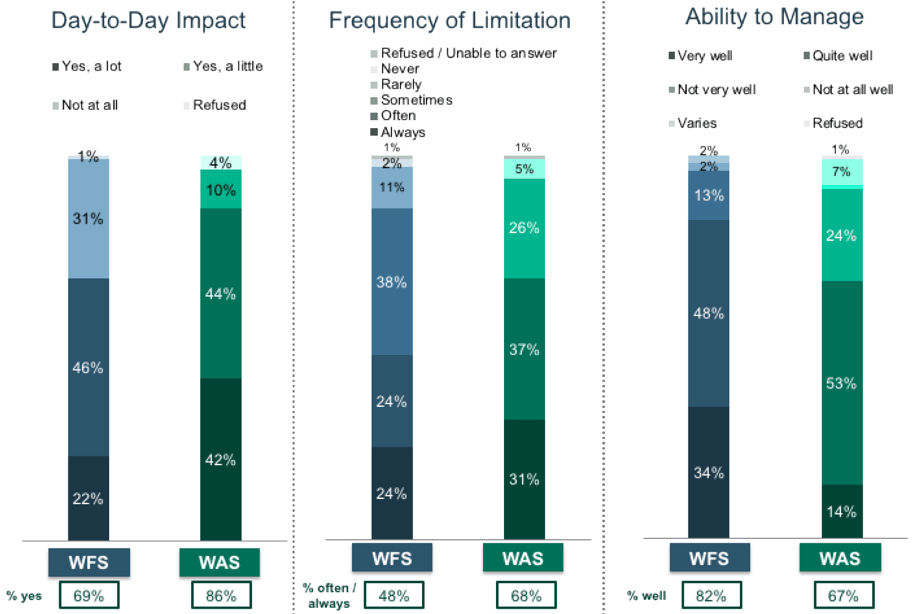
Source: IFF Research Telephone survey of WFS and WAS customers
G4. Does your health or disability reduce your ability to carry out day-to-day activities? / G5. How often does your health condition or disability limit the amount or kind of activities that you can do? / G6. Overall, how well would you say you are able to manage your health condition or disability on a day to day basis?
Base: WFS (n=499), WFS condition limits (N=346), WAS (n=201), WAS condition limits (N=174)
Customer attitudes towards work
Those living with a disability or long-term health condition have specific views on how their disability or condition impacts their work experience and their wider needs to ensure success. Customers were asked their opinion on a series of statements about these needs and perceptions, the results of which are presented in Figure 2.2.
Figure 2.2 WFS and WAS customer perceptions and attitudes regarding work
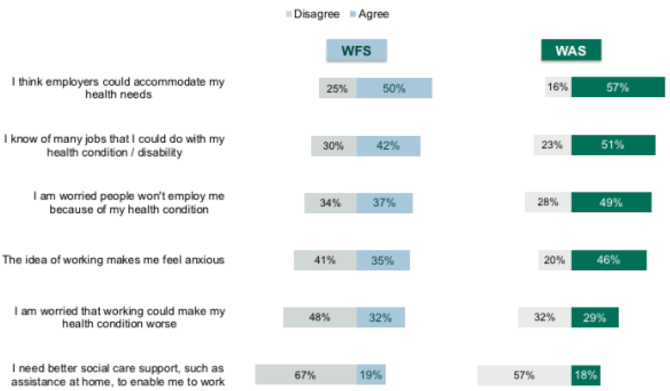
Source: IFF Research Telephone survey of WFS and WAS customers
E4. To what extent do you agree or disagree with the following statements about your health condition/disability and finding work
Base: those not currently in employment - WFS (n=341), WAS (n=172)
Overall, the order of statements in terms of the proportions who agree is identical between the two groups. Customers in both programmes are broadly positive about their employment prospects; around half of all customers agree that employers could accommodate their needs and that they know of jobs that could be done with their disability or condition. These individuals are more likely to have disabilities/conditions with minimal impact day-to-day and which are easily managed. They also have a greater desire to return to work and feel ready to return to work now. It is clear that both services engage with customers who see work as a possibility.
The next most common attitudes are more negative; between one third and a half of all customers are concerned about not finding work because of their disability or health condition and get anxious when thinking about work. These individuals were more likely to have mental health conditions or disabilities which impact their day-to-day lives, are difficult to manage and which, they felt, prevented or reduced their ability to work. They were also more likely to have been out of work longer ( e.g. 5+ years) than others.
Similar proportions of both WFS and WAS customers (32% and 29%) were concerned about the impact work will have on their health and feel they needed more social support in order to help them work. These individuals are more likely to have disabilities or health conditions with higher day-to-day impact and to feel that their disability/condition prevents or reduces their ability to work. Similar to the finding above, they were more likely to have been out of work longer than five years.
Barriers to work
Barriers to work are split between three broad themes: disability or health-related barriers, access or experience barriers, and personal barriers. WAS customers report a considerably higher proportion of disability or health-related barriers, while WFS customers are more likely to report considerably access or experience-related barriers. The full list of barriers is shown in Figure 2.3.
In terms of disability or health-related barriers:
- 39% of WAS and 21% of WFS customers feel their disability or health condition prevents them from working, while 39% of WAS and 13% of WFS customers feel their mental health conditions prevents them from working. This is consistent with the high proportion of WAS customers with a mental health condition.
- 21% of WAS and 20% of WFS customers feel their physical health condition prevents them from working.
Looking at access or experience-related barriers:
- 20% of WFS customers did not feel they have the qualifications, skills or experience to get work, considerably higher than WAS customers (8%).
- 11% of WFS customers did not feel there are suitable jobs in their local area, also higher than WAS (5%).
- Equal proportions of WFS and WAS customers lacked confidence to apply for jobs (9%, 10% respectively), would find it difficult to travel to work (6%, 7% respectively) and don't know what suitable jobs are available (4%, 6% respectively).
Personal barriers have extremely low incidence (c. 5% or less), covering age-related concerns, caring responsibilities and lack of confidence.
Figure 2.3 WFS and WAS customer barriers to working
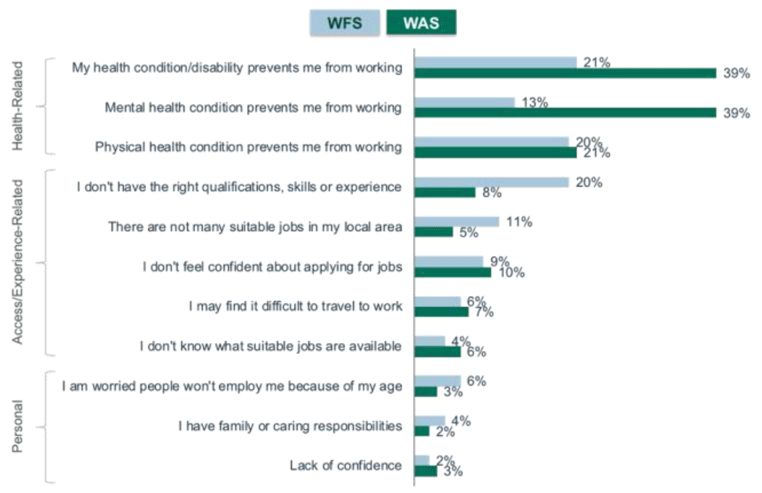
Source: IFF Research Telephone survey of WFS and WAS customers
E5. What would you say are the main issues or barriers preventing you from working? Responses with 2% or less are not shown.
Base: those not currently in employment - WFS (n=341), WAS (n=172)
Further investigation of the survey responses suggests differences between respondents based on the following factors:
- As may be expected, those with disabilities or health conditions that impact their day-to-day activities are more likely to feel their disability/condition prevents them working, while also reducing confidence in applying for work. Those concerned specifically about a physical disability or condition are more likely to be always or often limited in their activities.
- Those who feel they could return to work now are more likely to feel they lack the right qualifications, skills or experience to do so. However, they are often also highly motivated to return to work.
- In terms of demographics, only age plays a significant role in these barriers. Younger ages are more likely to feel their mental health prevents them working (16-34 especially, 25-54 to a lesser degree), while older ages are more likely to feel a physical disability or condition prevents them working (age 45+).
- Those who have been out of work for two or more years are more likely to be older and, as a result, are concerned they will not be hired due to their age.
Programme referral and participation
This section assesses customer pathways into the programme, including sources of information, reasons for joining and ease of engagement.
Programme referral
Overwhelmingly, customers found out about the WFS and WAS programmes through a JCP adviser – this was the source for more than three-quarters of customers in both programmes ( WFS 73%, considerably higher for WAS at 85%). Other sources included being told by another organisation ( WFS 5%, WAS 3%), knowing other people in the programme ( WFS 4%, WAS 1%) and through friends or family ( WFS 3%, WAS 2%). The full list of sources for discovery are shown in Figure 2.4 below.
Figure 2.4 WFS and WAS awareness of WFS/ WAS services
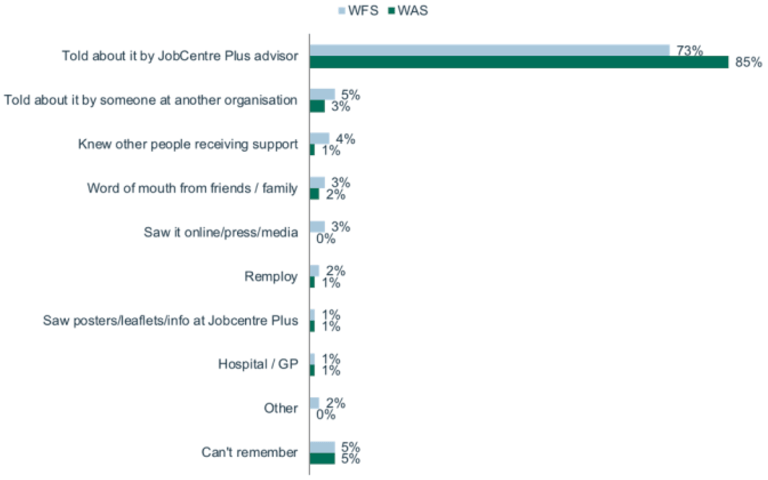
Source: IFF Research Telephone survey of WFS and WAS customers
C1. So can you tell me how you first became aware of this support service?
Base: WFS (n=499), WAS (n=201)
Rationale for joining
Customers were also asked why they decided to join the programme, the results of which are shown in Figure 2.5 below. For both programmes, nearly half of all customers thought the programme could help them get back into work (44% in each), while more than a third found the idea of additional help and support appealing ( WFS 36%, WAS 42%), and, similarly, just under a third really wanted a job ( WFS 29%, WAS 28%).
Figure 2.5 Reasons for engaging with WFS/ WAS
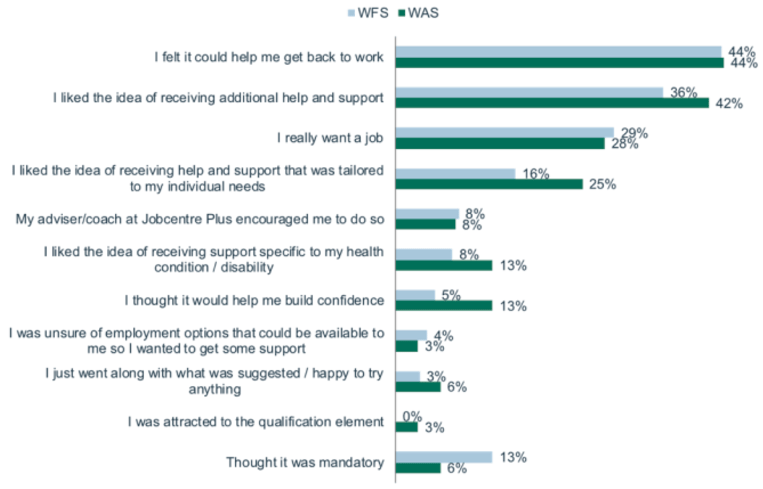
Source: IFF Research Telephone survey of WFS and WAS customers
C2. Were you aware when you signed up for this support that it is voluntary?/C4. Why did you decide to sign up for the support? Responses with 2% or less are not shown.
Base: WFS (n=499), WAS (n=201)
Customers in WAS were considerably more likely to join for the following reasons:
- Tailored help and support – 25% ( WFS 16%)
- Help build confidence – 13% ( WFS 5%).
These higher proportions looking for individual support suggests WAS customers are seeking a high degree of personalisation in its programme to help address their specific health needs but also address their lower levels of confidence by building trust.
Those who said they joined to help them get back into work are considerably more likely to have a disability/health condition that affects them regularly, while those who said they joined due to wanting a job are more likely to not be receiving any benefits, feel ready to return to work 'now', had high motivation to work and are also more likely to already be employed (at the time of interview).
A minority in each service reported that at the point of initial referral they thought the programme was mandatory ( WFS 13%, WAS 6%). Of these:
- About half said that they were told it was mandatory by a coach or adviser at JCP
- Just under half assumed it was mandatory based on prior benefits experience or other reasons
- A small number were told it was mandatory by friends or peers
Ease of joining
The majority of customers in both programmes found the process of joining their programme easy – 77% among WFS customers and 80% among WAS customers. The full breakdown of scores is shown in Figure 2.6 below.
Figure 2.6 Ease of joining the programme
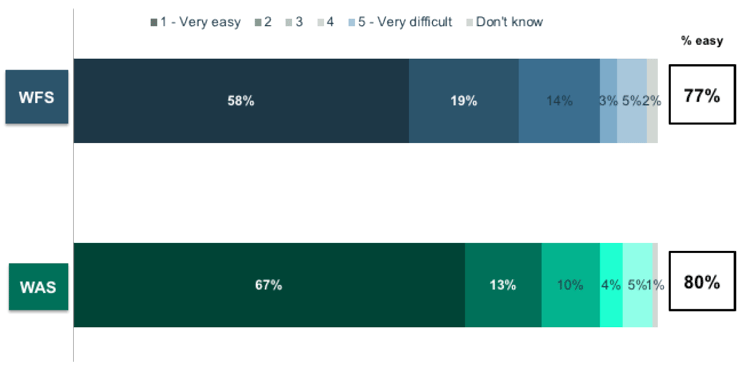
Source: IFF Research Telephone survey of WFS and WAS customers
C5. How easy would you say it was to sign up for the WFS/ WAS support service?
Base: WFS (n=499), WAS (n=201)
Fewer than 10% in each programme found the process difficult. Those who did were more likely to have lower academic achievement and a disability or condition that impacts them day-to-day. This chimes with the frontline advisers' view that the language used in some documentation was too complex and not accessible to customers as well as the relatively long time taken to complete the initial assessment process.
Service uptake and performance
This section assesses customers' experience of the programme in terms of which services they were offered, took up and found useful, as well as looking specifically at the experience of working with dedicated case managers.
Access to services
Both WFS and WAS offered similar services to customers: one-to-one appointments, a dedicated case manager, an individual assessment, work-related health and well-being support (occupational therapy) and access to work tasters, experience and apprenticeships. Customers could choose which of these services they wanted to use.
Customers were asked to specify in the survey which services they were offered and took up, and of these services, if they were helpful, in order to assess the total take up and performance of each of these five service options. These reponses cover some who have recently referred to the programme (4-6 weeks earlier) and may not have had time to be offered some elements of support, those who are on the programme (39% of WFS and 77% of WAS respondents were still participating) and those who have left. The size of the survey does not allow the responses to be stratified by the status of the customers at the time the interviews were undertaken, and so some care is required when interpreting these results. The full results are shown in Figure 2.7 below.
Figure 2.7 Services offered, taken up and found useful
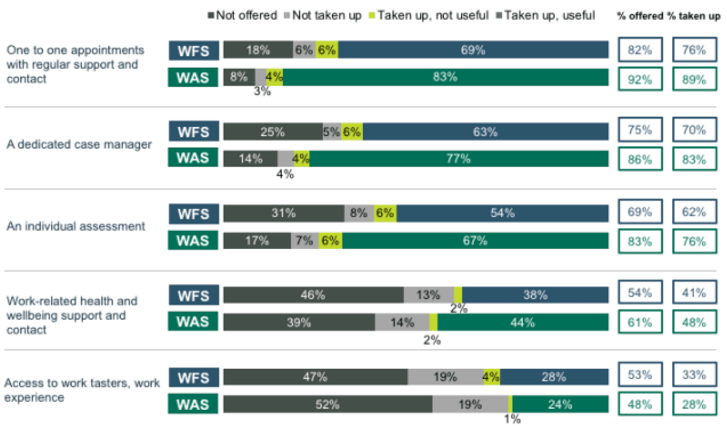
Source: IFF Research Telephone survey of WFS and WAS customers
D5a. Were you offered the following support as part of your WFS/ WAS service?/D5b. Did you take up the following support as part of your WFS/ WAS service?/D6. Were each types of support you received useful or not useful to you?
Base: WFS (n=499), WAS (n=201)
For WFS, there are a number of key points:
- One to one weekly appointments and initial Individual Assessments ( IA) are fundamental to the design of WFS and providers should make every effort to ensure customers have a dedicated case manager. This is reflected in the high proportions to have been offered and taken up these services. Regular one-to-one appointments are highly rated (91% of those taking them up said they were useful) and nine in ten who have taken up the service appreciated the dedicated case manager.
- For such a fundamental element of the WFS service, relatively high proportions report that they were not offered one to one appointments and regular support or a dedicated case manager (18% and 25% respectively). This may reflect high referral volumes, customers dropping out early and that some respondents may only have been recently referred to the programme. Frontline advisers also reported that as WFS customers gained confidence, they were often engaged in peer group work with other customers at a similar stage as this was found to increase confidence and motivation to undertake training and other job search activities.
- Some 87% of those reporting that they had taken up Individual Assessments found them to be useful. However, almost a third reported that they had not been offered such support – this may well be a combination of relatively recent referrals or customers not recognising the assessments.
- Proportionately fewer customers report that they have been offered work-related health and wellbeing support, work tasters or work experience. Again, such support is offered later in the process and so a proportion of customers may not have reached this stage at the point of interview. Some 93% of those that had taken up this element of support found it useful. Customers taking it up were more likely to be on PIP/ DLA benefits. However, a more significant proportion report that they did not take up this support when it was offered.
- Work tasters and placements were offered to just over half of WFS customers and taken up by a third. Again, most reported that this support was useful (85%) but almost a fifth reported that they did not take up the support when it was offered. This support was more likely to be taken up by those whose disabilities or health conditions do not impact them day-to-day, are well able to manage their disability or condition, and who feel ready to return to work now.
- The proportion who had taken up support and not found it useful were relatively low – less than 10% in all cases other than work tasters and placements which was 12%.
WAS has similar service criteria in terms of regular individual support, dedicated case managers and assessment. However, there is a somewhat different pattern of take-up which reflects the longer periods of one-to-one support reported by WAS frontline staff. This support was necessary to build customers' trust and confidence and to provide the time necessary to support customers to point where they are ready to undertake work search. Key points to note for WAS were:
- One-to-one appointments were offered to 92% of WAS customers, taken up by 89% and deemed useful by 93% who took up the support.
- Dedicated case managers were offered to 86% of WAS customers, taken up by 83% and deemed useful by 97% of those who took up the support.
- Individual assessments were offered to 83% of WAS customers, taken up by 76% and deemed useful by 88% of those who took up the support.
- Occupational therapy and other health and wellbeing support was offered to 61% of WAS customers, taken up by 48% and deemed useful by 92%. The previous section clearly identified the much higher health needs of WAS customers and this is reflected in their take up of this support and satisfaction with it.
- Work experience placements were offered to 48% of WAS customers, taken up by 28% and deemed useful by 86% of those who take up the support. Proportionately fewer WAS customers had reached the stage where such support was relevant to their situation (the time taken to support WAS customers to a point where they had the confidence to take this step was widely reported by frontline advisers).
- WAS customers who took up support and found it not useful were mostly below 5% in all categories other than individual assessment (8%) and reinforce the satisfaction with support.
Unfortunately, the survey can't determine why some WAS clients turn down elements of support when it is offered to them. This was a particular issue with work-related health and wellbeing support and access to work tasters and work experience.
Dedicated case managers
Those who have/had a dedicated case manager as part of their support were asked specifically about the frequency of contact with this person and whether it was enough. Supporting each customer for a minimum hour a week face-to-face is a key design principle of both programmes, closely monitored by Scottish Government and SDS contract management staff.
As shown in Figure 2.8, more than 80% of customers in both programmes felt the frequency of contact with their case manager was the right amount. About 1 in 20 felt it was too much, while less than 10% felt the contact was not frequent enough.
Figure 2.8 Case manager contact frequency
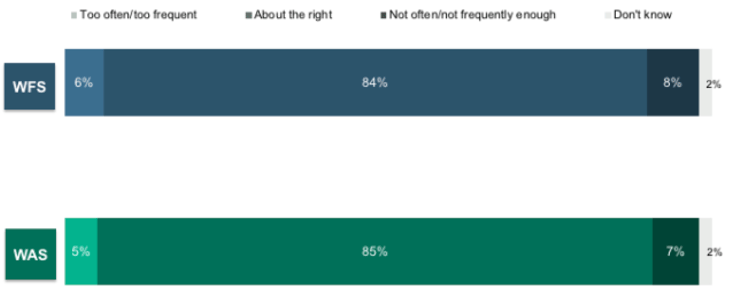
Source: IFF Research Telephone survey of WFS and WAS customers
D8. Would you say that the frequency of your meetings with your case manager was/is?
Base: those who took up CM service – WFS (n=353), WAS (n=166)
Overall, case manager contact is proving sufficient for the majority of customers. Those customers who felt the contact was too frequent were more likely to have a disability or health condition that does impact them day-to-day and which they struggle to manage. This closely reflects the views of frontline advisers who have developed alternative procedures to help customers who find travel to their premises challenging. It did take some time to gain approval to see some customers by video link but has become an accepted alternative. There were no other meaningful differences by demographics, conditions or other relevant factors.
Programme participation
A lower proportion (39%) of WFS customers were still receiving support at the time of the survey and tended to have been on the programme for a shorter period of time, with 62% receiving support for less than six months. Pre-employment support for customers on WFS is available for up to a maximum of 26 weeks. It is possible to extend participation for a further 8 weeks by application to Scottish Government. However, this was reported as being relatively infrequent and combined provider MIS data for WFS suggests that for those who had exited the programme by the end of October 2017, only 5% of this group had been on the programme for more than 26 weeks. This suggests that customers' recollection of the time they have been on the programme is not precise. These figures are illustrated in 2.9 below.
Looking at WFS, those who remain engaged with the service tend to report higher levels of motivation to return to work, feel prepared to return to work some or all of the time, and have health condition(s) that they can manage.
Figure 2.9 Current programme participation and duration of support
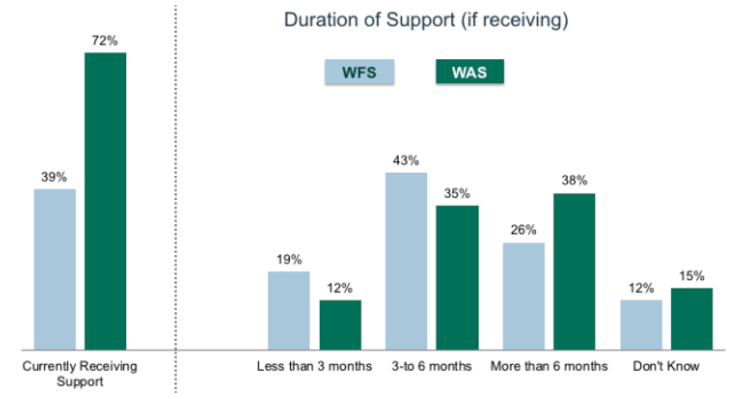
Source: IFF Research Telephone survey of WFS and WAS customers
D1. Are you currently receiving support from the WFS/ WAS service to help you move into employment?/
D2. And when did you start receiving this support?/D3. When did you stop receiving this support?
Base: WFS (n=499) WFS receiving support (n=193), WAS (n=201), WAS receiving support (n=143)
At the time of interview, 72% of WAS customers were receiving support, 36% for more than six months. Among WAS, support levels were highest among those who have a National 1-5 degree (vs. those with Highers, Advanced Highers or above), those who feel they could return to work 'some' days, and those who manage their condition well. On average, those who had left the programme participated for just over 10 weeks while those who were still participating had an average duration of just over 20 weeks at the end of October 2017 [10] .
Across both programmes, those no longer receiving support in the programme are more likely to have a 'high impact' disability or health condition, namely one which limits their day-to-day activities, and who have been out of work some or all of the five years preceding their interview. This group are more likely to have left the programme.
There are no significant differences in support levels by other demographics, including by type of condition or disability within either group.
Contact
There is a problem
Thanks for your feedback